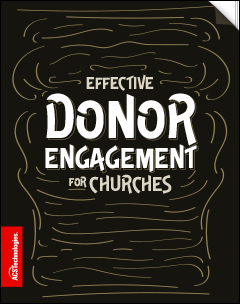In this series, we’re applying the best practice development concepts of The Four-Part Cycle of Donor Engagement to the church setting. We’re sharing ideas and tools for best leveraging church staff and volunteer leadership in each of the phases. In this four-part cycle, the donor is always at the center, which helps us ensure an effective and fulfilling donor experience.
Unfortunately, givers to other organizations are often treated and thanked more effectively by them than by their own churches. In the last two blogs, we’ve looked at the first two phases, which are acknowledgment and trust-building. The third phase is presenting the case for support.
In the church, the case for support most often looks like one of three things: a capital campaign, an immediate need fundraiser, or the annual stewardship campaign. No matter where you find yourself as a church in this season, the practical tools in this blog will help you prepare to make the best possible case to your donors.
Four Essential Components
In the philanthropic development world, when we present a case for support to a major donor, it always has four essential components. There is a problem, a solution, a strategy and an invitation to partnership to solve the problem.
While those four components are most translatable to a campaign or immediate need. We should be able to articulate it even for our annual stewardship campaigns. What problem is the tither solving with their tithe? Instead of the appeal you typically generate during your stewardship campaign, consider reframing your approach. See the giver as the partner or hero in your church’s story. Tell the story from that perspective.
Here’s an example:
Each Wednesday, 30 high schoolers and 20 middle schoolers experience a time of fun, service and spiritual formation together. Their parents have a time of fellowship, Bible study and connection. These 50+ families are nourished and energized to be Christ’s hands and feet each week during their Wednesday night gathering. Your gift makes it possible for us to underwrite the $750 weekly cost of food, supplies, facilities and staff time. Without you, we would not be able to offer this important time for our families, which over the last months has also attracted new prospective members. Thank you for partnering with us in this important ministry.
That Wednesday night session might be something you’ve offered for some time – it’s on autopilot and it’s not a new program looking for funding. But in truth, it has a hard cost and your loyal donors are funding it. It has a value for your members and your outreach. Seek to frame the impact of your ministry. Especially those parts people might take for “granted.” Do it in a way that shows the donor as the central protagonist of your church’s story.
The more you and your staff can be specific about that donor impact, the better prepared you will be to launch an annual pledge drive or a campaign for a project. Be transparent and work hard to name those tangibles that donors can underwrite with their generosity.
Pastors
A word about donor nuances, especially in the case for a capital project or campaign. For your most major donors, your acknowledgment and trust-building phases will have given you a strong sense of their readiness or interest in the campaign. How you approach them about this – especially lead gifts – must grow out of your understanding of the individual donor’s learning style.
It helps to have a range of materials and types of presentations at your disposal. Then you can communicate effectively regardless of an individual donor’s specific ‘wiring.’ How does this individual instinctively prefer to receive information? Be flexible so you can communicate on the donor’s unique wavelength. Present the case for support in a style that enables the specific donor, to say, ‘I get that!’ Some donors prefer to receive lots of information in advance of a meeting. Some prefer to have a casual conversation over lunch. Yet others prefer to be buried in audit numbers and information. The message must come through in a medium that makes sense to the donor.
Conclusion
All of this prep work keeps the donor’s style, interests and passion at the center. When we’re building authentic and trust-filled relationships, we can’t take shortcuts. Nor can we rush the process or manipulate donors. Even when we feel pressure to hit our budget or campaign goals.
In the final blog of this series, we’ll take the mystery out of making the ask of our givers. Which is the final phase of the four-part donor engagement cycle.
Effective Donor Engagement for Churches
No matter where you find yourself as a church in this season – from planning a capital campaign to thanking annual pledge donors – the hands-on, simple tools in this guide will help you and your staff effectively acknowledge and engage your best givers.
Tim Smith has over 30 years of experience in Church, Non-Profit Administration, Management, and Fund Development. Serving as an Executive Pastor and Chief Development Officer in growing Churches and Non-Profit Organizations has provided a wide range of expertise and resources. Tim serves as Founder and CEO for Non-Profit DNA. His boutique firm is committed to helping nonprofits and churches build their capacity. By using fundraising, leadership, team building, staff recruiting, and coaching.





